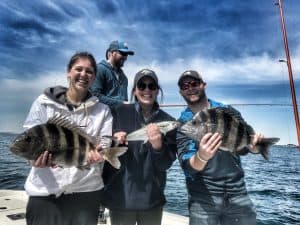Sheepshead Fishing
Springtime Sheepshead fishing
It happens every year. Winter turns to spring, spring to summer, summer to fall and fall to winter. Regardless if you want it to happen the seasons change and so do the fish that we target. Springtime sheepshead fishing is a great way to enjoy a day on the water with friends and or family. Once the springtime sheepshead bite begins in March or April it will generally last 4 to 8 weeks. Why is the Springtime so important or why is it so good?
Sheepshead migration
Sheepshead, convicts, goats, or bait stealers. Whatever you want to call them they are almost always migrating from one area to another. They are locally pelagic (if that is even a term). We will begin in the Winter. Sheepshead are going to be found mostly in the rivers or canals around the main body of water and in my case is Mobile Bay. They will stage up in these areas and with each passing cold front more of them will leave and begin migrating toward the saltiest areas with an abundance of structure. Here in the Mobile Bay area this will be the lower Mobile Bay and upper Gulf of Mexico. As Spring arrives these fish will begin to congregate around the large structures in your area. This is where sheepshead will go through the annual spawning ritual. Nearly all the sexually mature sheepshead will be near these high salinity large structure areas for the spawn. Once the spawn is complete most of these fish will return to the bays and rivers for the Summer, fall and winter.
The Spawn
Sheepshead spawn in large groups. This means competition is high for food. Each piece of structure could hold hundreds to thousands of fish. This high competition for food is what can make the fishing so great. Once these fish arrive on the structure they can be a little depleted and will require lots of calories to get them ready to spawn.
Locating
First, wait till around mid March and go into the gulf and look around big structure like gas platforms. Always try and locate the cleanest water. I will use a combination of using my sonar and my eyes to locate the largest schools of sheepshead. If you look into the water and see two fish on this pole and two or three on the next pole and a couple more cruising from pole to pole then this is where you want to fish. If I am not seeing them then I will watch my sonar to locate a school of fish (this may not be sheepshead). Drop a couple baits and see what happens. It could be a school of spanish, spadefish, red snapper, or even redfish. My recommendation is if you drop a bait in or near the school and you don't get bit within about 2 minutes then its time to move.
Tackle
Early in March when these fish are showing up they can be picky. The reason for this is usually not enough competition. The main way to catch these pickier fish is to use a straight freeline with flourocarbon leader. I recommend at least 10# but know more than 20#. If the freeline isn't dropping in the strike zone then add spit shots till you find the right amount of weight. As the rest of the herd arrives you can tyically go up in tackle size to reduce the risk of break-offs.
Have Fun
The main thing with fishing for me and my guests is to have fun and enjoy everyday on the water. This kind of sheepshead fishing is typically as fun of fishing that you can imagine. Drop a live shrimp and hang on. Sheepshead pull really hard and have a don't quit attitude. While the sheepshead are swarming around the rigs/offshore structure they are usually competing with red snapper, triggerfish, pompano, spanish mackerel and bluefish. Enjoy all the drag pulling action.
Y'all enjoy!
Sheepshead video with Jason Smith Fox10 Outdoors

